Modeling and Cleaning Performance Optimization of Conical Filter Cartridge of Gas Turbine Intake Filter
Abstract
:1. Introduction
- (1)
- The issues discussed are novel in view of the fact that the pulse cleaning performance of conical filter cartridges is studied for the first time in this paper, and it is proposed to install scattering nozzles to further optimize the cleaning performance of conical filter cartridges;
- (2)
- The CFD of ICEM and FLUENT were adopted to establish a 2D axisymmetric model of the conical filter cartridge dust collector. The results denote that the conical filter cartridge increases the pressure peak on the upper part of the conical filter cartridge, but the cleaning uniformity needs to be improved;
- (3)
- To improve the uniformity of the conical filter cartridge, a scattering nozzle is proposed to improve the pulse cleaning effect of the dust collector in conjunction with the conical filter cartridge. The numerical simulation results indicate that adding the scattering nozzle improves the cleaning uniformity inside conical filter cartridge by nearly two times;
- (4)
- The influence of the installation position of the scattering nozzle on the cleaning effect was studied. It is found that the cleaning performance of the conical cartridge filter is the best when the scattering nozzle is installed in parallel with the inlet of the conical cartridge filter. The research results serve as a valuable for optimizing the pulse cleaning effect of the conical cartridge filter.
2. Model and Methods
2.1. Modeling and Meshing
2.2. Solution Method and Boundary Conditions
3. Results and Discussion
3.1. Dynamic Analysis of Pulse Cleaning with Conical Filter Cartridge
3.2. Synergistic Effect of Scattering Nozzle and Conical Filter Cartridge
3.3. Optimum Installation Position of Scattering Nozzle
4. Conclusions
- (1)
- The numerical simulation reveals that the accumulation of pressure inside the conical filter cartridge is more obvious when applying normal nozzles. Although the injection strength of conical filter cartridge is better than that of the cylindrical filter cartridge, the injection uniformity needs to be improved;
- (2)
- The scattering nozzle is installed under the normal nozzle to improve the cleaning effect with the conical filter cartridge. The results denote that, compared to the pulse cleaning combination lacking a scattering nozzle, the injection uniformity KP decreased from 0.32 to 0.17, the injection uniformity increased by nearly double, and the cleaning intensity satisfied the cleaning demand;
- (3)
- The influence of the installation position of the scattering nozzle on the cleaning effect was studied. The results denote that the cleaning performance of the conical filter can be optimized to the greatest extent when the scattering nozzle is parallel to the inlet of the conical filter. At this time, the injection uniformity is 0.11, and the upper and lower parts of the conical filter can ensure the cleaning power (higher than 600 Pa).
Author Contributions
Funding
Institutional Review Board Statement
Informed Consent Statement
Data Availability Statement
Acknowledgments
Conflicts of Interest
References
- Naylor, A.W.; Ford, J. Vulnerability and loss and damage following the COP27 of the UN framework convention on climate change. Reg. Environ. Chang. 2023, 23, 38. [Google Scholar] [CrossRef]
- Zeng, L.; Long, W.; Li, Y. A novel method for gas turbine condition monitoringbased on KPCA and analysis of statistics T2 and SPE. Processes 2019, 7, 124. [Google Scholar] [CrossRef]
- Talal, W.; Akroot, A. Exergoeconomic analysis of an integrated solar combined cycle in the Al-Qayara power plant in Iraq. Processes 2023, 11, 656. [Google Scholar] [CrossRef]
- Shu, G.; Yu, C.; Shen, G. Research on development of heavy gas turbines in China in new period. J. Eng. Sci. 2022, 24, 184–192. [Google Scholar]
- Poullikkas, A. An overview of current and future sustainable gas turbine technologies. Renew. Sustain. Energy Rev. 2005, 9, 409–443. [Google Scholar] [CrossRef]
- Walsh, P.P.; Fletcher, P. Gas Turbine Performance; John Wiley & Sons: Hoboken, NJ, USA, 2004. [Google Scholar]
- Wilcox, M.; Kurz, R.; Brun, K. Technology review of modern gas turbine inlet filtration systems. Int. J. Rotating Mach. 2012, 2012, 128134. [Google Scholar] [CrossRef]
- Jeong, K.; Jungho, H.; Hyun, C. Effective filtration area of a pleated filter bag in a pulse-jet bag house. J. Powder Technol. 2017, 31, 522–527. [Google Scholar]
- Ushio, M. Use of a filter cartridge combined with intra-cartridge bead-beating improves detection of microbial DNA from water samples. J. Methods Ecol. Evol. 2019, 10, 1142–1156. [Google Scholar] [CrossRef]
- Wakeman, R.J.; Hanspal, N.S.; Wanghode, A.N.; Nassehi, V. Analysis of pleat crowding and medium compression in pleated cartridge filters. Chem. Eng. Res. Des. 2005, 83, 1246–1255. [Google Scholar] [CrossRef]
- Li, J.; Wang, P.; Wu, D. Numerical study of opposing pulsed-jet cleaning for pleated filter cartridges. J. Sep. Purif. Technol. 2020, 234, 116086. [Google Scholar] [CrossRef]
- Lo, L.; Hu, S.; Chen, D. Numerical study of pleated fabric cartridges during pulse-jet cleaning. J. Powder Technol. 2010, 198, 75–81. [Google Scholar] [CrossRef]
- Li, H.; Choi, J.; Li, B. Numerical analysis on the gas flow dynamics from a rectangular slot-nozzle for pulse cleaning of filter unit. J. Powder Technol. 2016, 297, 330–339. [Google Scholar] [CrossRef]
- Chen, S.; Wang, Q.; Chen, D. Effect of pleat shape on reverse pulsed-jet cleaning of filter cartridges. J. Powder Technol. 2017, 305, 1–11. [Google Scholar] [CrossRef]
- Yan, C.; Liu, G.; Chen, H. Effect of induced airflow on the surface static pressure of pleated fabric filter cartridges during pulse jet cleaning. J. Powder Technol. 2013, 249, 424–430. [Google Scholar] [CrossRef]
- Yuan, N.; Ren, L.; Wang, B. Experimental study on the effects of diversion device on pulse-jet cleaning of horizontal filter cartridge. J. Process Saf. Environ. Prot. 2021, 145, 247–254. [Google Scholar] [CrossRef]
- Li, J.; Wu, D.; Wu, Q. Design and performance evaluation of novel colliding pulse jet for dust filter cleaning. J. Sep. Purif. Technol. 2019, 213, 101–113. [Google Scholar] [CrossRef]
- Li, S.; Zhou, F.; Xie, B. Influence of injection pipe characteristics on pulse-jet cleaning uniformity in a pleated cartridge filter. J. Powder Technol. 2018, 328, 264–274. [Google Scholar] [CrossRef]
- Xie, B.; Pang, J.; Hu, S. A new method to improve the pulse-jet cleaning performance of filter cartridges and its application to dust control in underground coal mines. J. Powder Technol. 2012, 405, 117528. [Google Scholar] [CrossRef]
- Zhang, Q.; Yuan, R.; Lv, Y.; Li, Z.; Wu, H. Multivariate dynamic mode decomposition and its application to bearing fault diagnosis. IEEE Sens. J. 2023, 23, 7514–7524. [Google Scholar] [CrossRef]
- Yuan, R.; Lv, Y.; Xu, S.; Li, L.; Kong, Q.; Song, G. ResNet-integrated very early bolt looseness monitoring based on intrinsic feature extraction of percussion sounds. Smart Mater. Struct. 2023, 32, 034002. [Google Scholar] [CrossRef]
- Lv, Y.; Yuan, R.; Song, G. Multivariate empirical mode decomposition and its application to fault diagnosis of rolling bearing. Mech. Syst. Signal Process. 2016, 81, 219–234. [Google Scholar] [CrossRef]
- Yuan, R.; Lv, Y.; Wang, T.; Li, S.; Li, H. Looseness monitoring of multiple M1 bolt joints using multivariate intrinsic multiscale entropy analysis and Lorentz signal-enhanced piezoelectric active sensing. Struct. Health Monit. 2022, 21, 2851–2873. [Google Scholar] [CrossRef]
- Yuan, R.; Lv, Y.; Lu, Z.; Li, S.; Li, H. Robust fault diagnosis of rolling bearing via phase space reconstruction of intrinsic mode functions and network under various operating conditions. Struct. Health Monit. 2023, 22, 846–864. [Google Scholar] [CrossRef]
- Zhang, A.; Yu, D.; Zhang, Z. TLSCA-SVM fault diagnosis optimization method based on transfer learning. Processes 2022, 10, 362. [Google Scholar] [CrossRef]
- Wang, Y.; Ren, W.; Liu, Z.; Li, J.; Zhang, D. T-S fuzzy model-based fault detection for continuous stirring tank reactor. Processes 2021, 9, 2127. [Google Scholar] [CrossRef]
- Xie, B.; Yan, Z.; Du, Y.; Zhao, Z.; Zhang, X. Determination of holmquist–johnson–cook constitutive parameters of coal: Laboratory study and numerical simulation. Processes 2019, 7, 386. [Google Scholar] [CrossRef]
- Zhang, Q.; Chen, H.; Ju, M.; Chen, J. Experimental study on improving pulse ash cleaning effect of filter cylinder by induced nozzle. J. Environ. Eng. 2012, 30, 62–65+138. [Google Scholar]
- Yan, C.; Zhang, M.; Lin, L.; Chen, H. An analysis of a reverse pulse cleaning process using high-flow pleated fabric filter cartridges. J. Process Saf. Environ. Prot. 2018, 113, 264–274. [Google Scholar]
- Chen, S.; Chen, D. Numerical study of reverse multi-pulsing jet cleaning for pleated cartridge filters. J. Aerosol Air Qual. Res. 2016, 16, 1991–2002. [Google Scholar] [CrossRef]
- Su, Z.; Lin, Z.; Li, J. Numerical simulation of improving the cleaning performance of gold cone filter cylinder by pulse spraying with Venturi nozzle. Chin. J. Environ. Eng. 2022, 16, 220–229. [Google Scholar]
- Gao, D.; Zhou, G.; Yang, Y. Design of pulse cleaning device for single-filter cartridge dust collector by multi-factor orthogonal method based numerical simulation. Powder Technol. 2021, 391, 494–509. [Google Scholar] [CrossRef]
- Wu, Q.; Xie, W.; Chen, J. Effect of annular baffles on the pulsed-jet performance of dust filter cartridge regeneration. Powder Technol. 2023, 421, 118450. [Google Scholar] [CrossRef]
- Wang, B. Application of fluid simulation technology in nozzle flow field analysis. Chin. J. Mach. Ind. Stand. Qual. 2019, 5, 35–39. [Google Scholar]
- Zhu, Y.; Zuo, D.; Yang, X. Numerical simulation study on pulse back-blowing cleaning process of combined filter cartridge. Fluid Mach. 2020, 48, 23–28. [Google Scholar]
- Wang, S.; Liu, D.; Yu, H. Analysis of dynamic characteristics of pulse flow field and cleaning pressure based on scattering structure. Chin. J. Environ. Eng. 2021, 39, 89–95. [Google Scholar]
- Liu, D.; Yu, H.; Wang, L. Experiment on improving pulse injection cleaning performance by upper open diffuser. Chin. J. Environ. Eng. 2019, 37, 138–142. [Google Scholar]
- Zhang, Q.; Liu, D.; Wang, M. Characteristics and evaluation index of pulse-jet dust cleaning of filter cartridge. J. Process Saf. Environ. Prot. 2022, 157, 362–374. [Google Scholar] [CrossRef]
- Li, J.; Chen, Y.; Lin, Z. Research progress and prospect of pulse spray dust cleaning technology of dust removal filter. J. Met. Mine 2022, 51, 23–35. [Google Scholar]
- Li, T.; Qi, S.; Huang, S. Comparison and application of evaluation index of flow field velocity distribution uniformity. J. Therm. Power Gener. 2013, 42, 60–63+92. [Google Scholar]
- Chen, Q.; Lin, Z.; Li, J. Numerical simulation of diffusion nozzles improving the performance of pulse spray cleaning of gold cone filter cartridges. Chin. J. Environ. Eng. 2021, 15, 1634–1644. [Google Scholar]
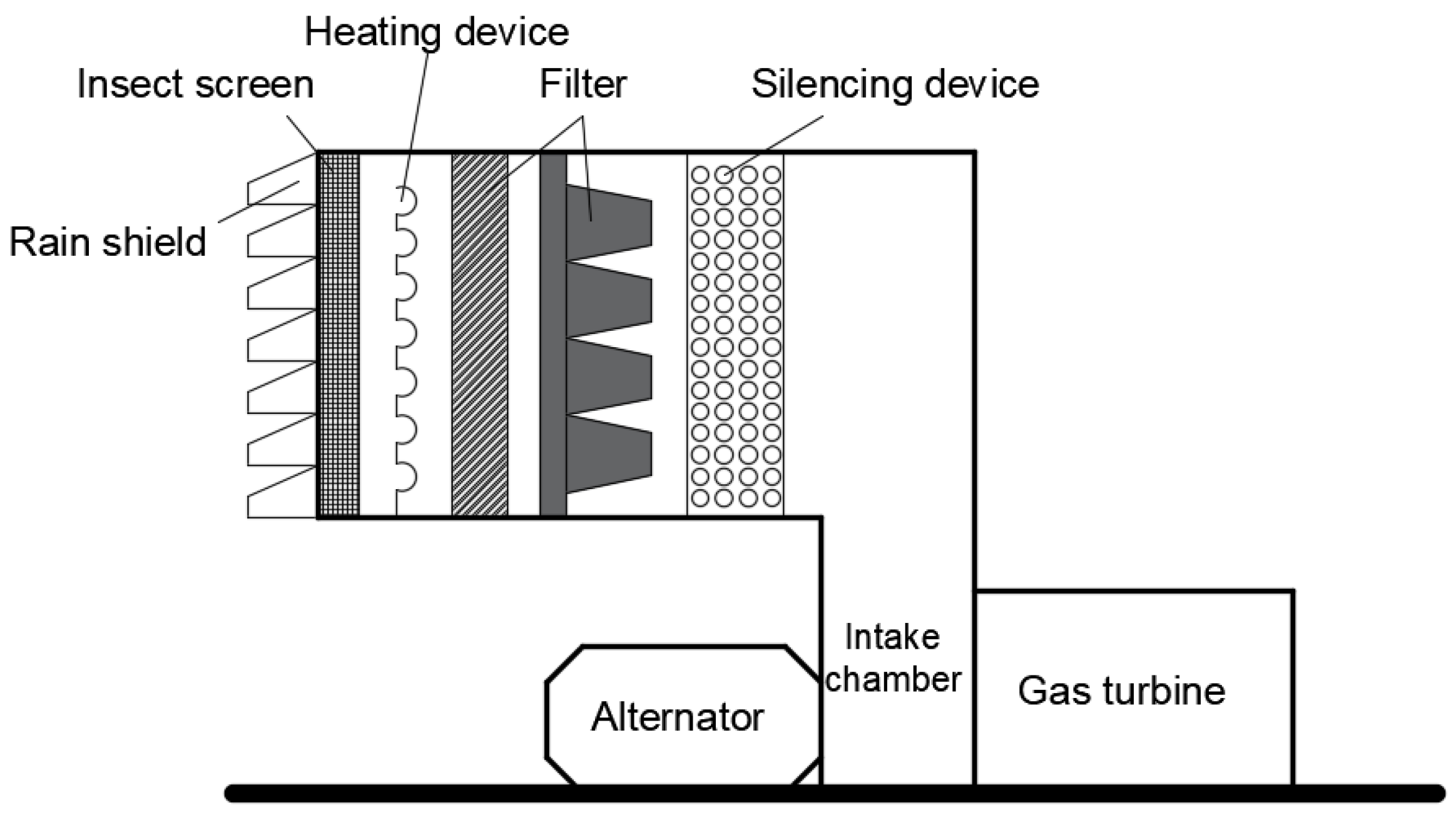
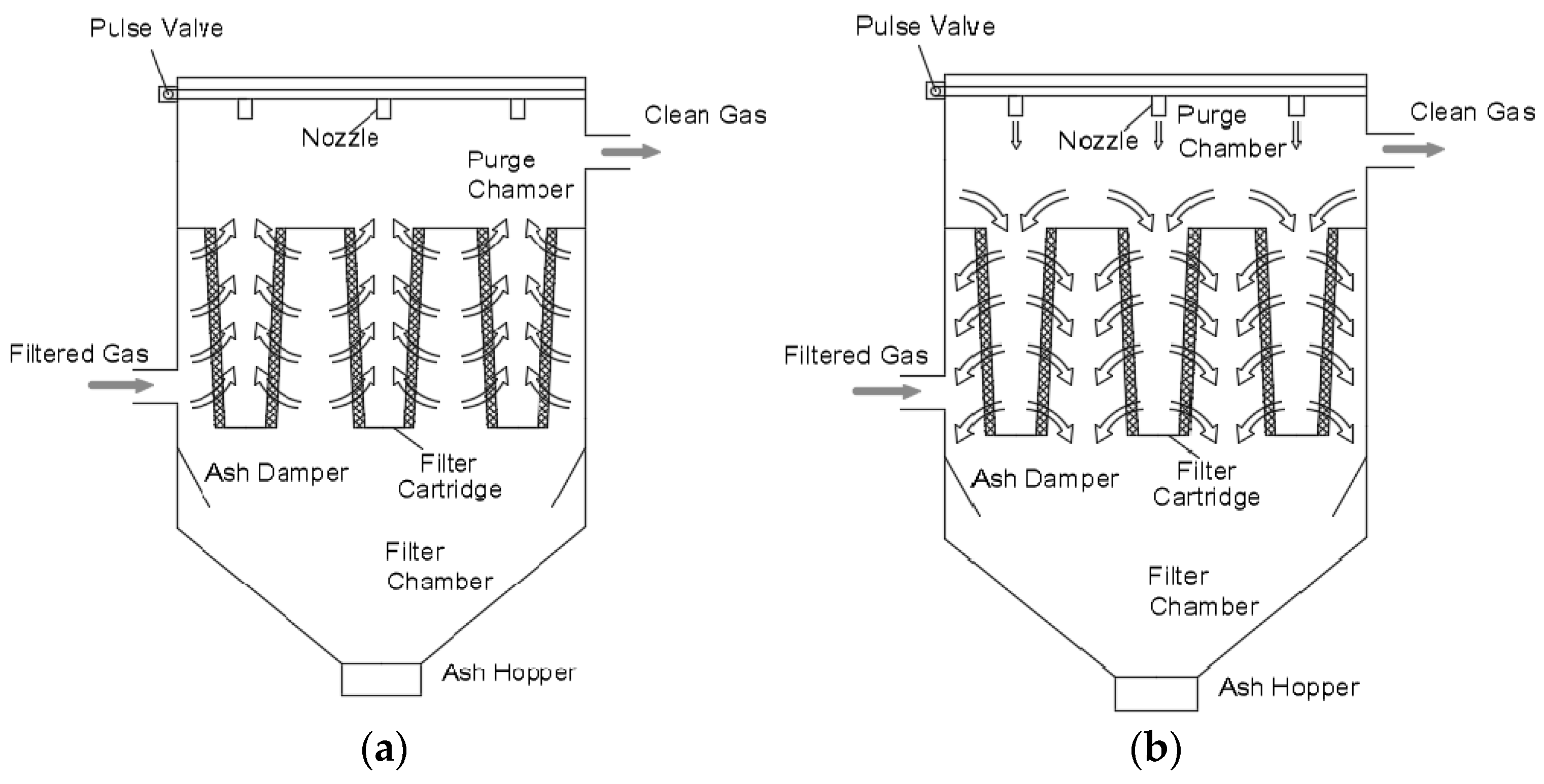
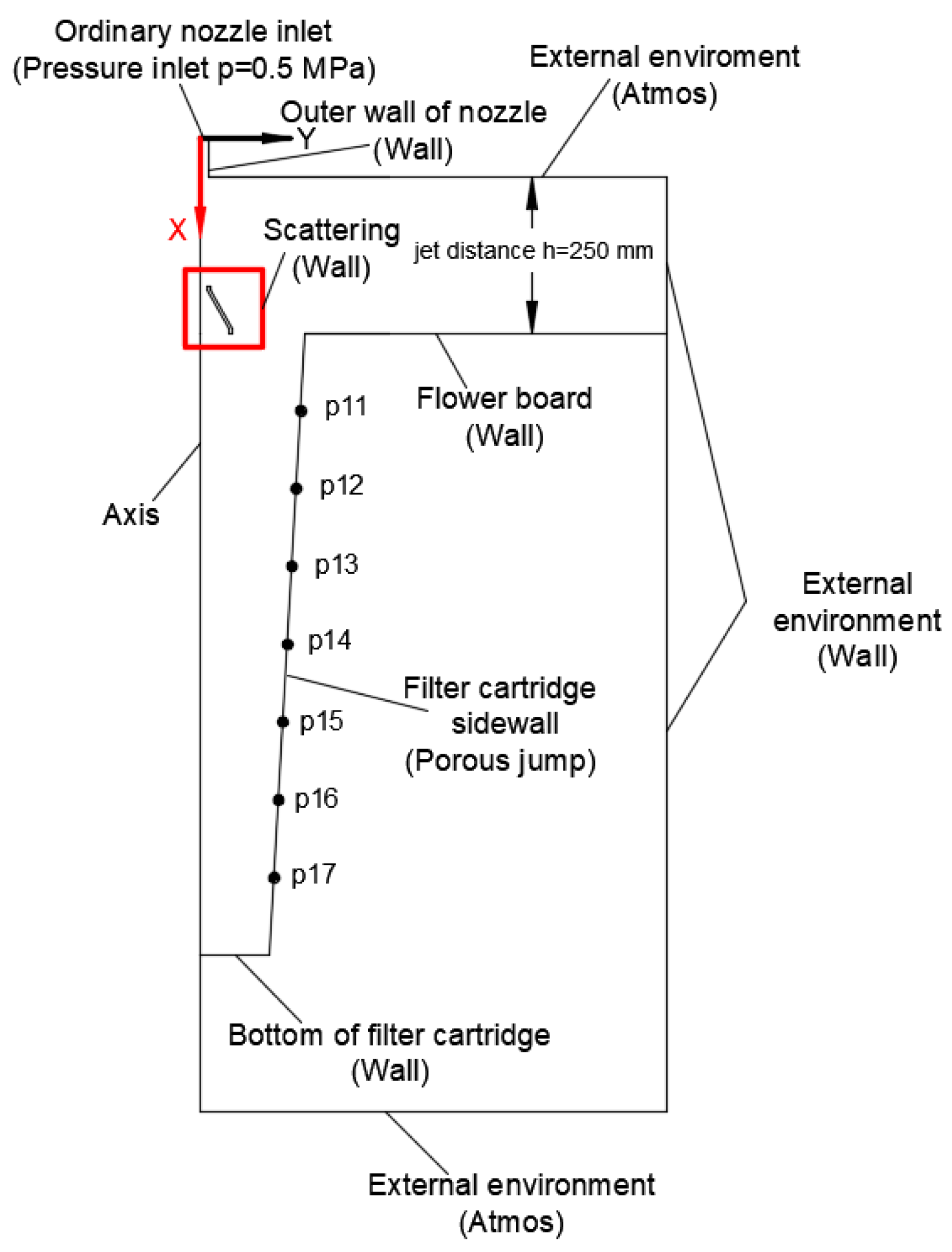


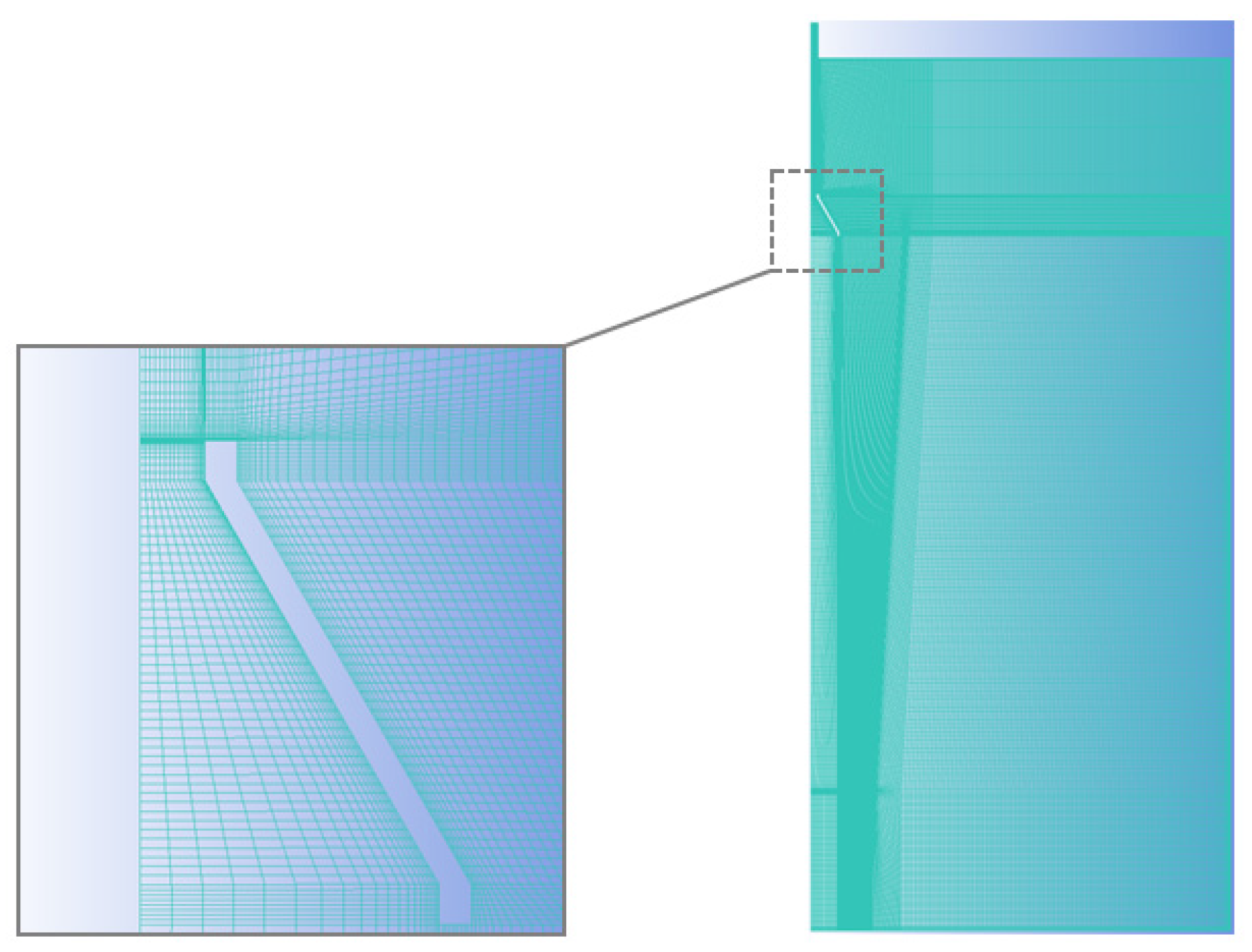

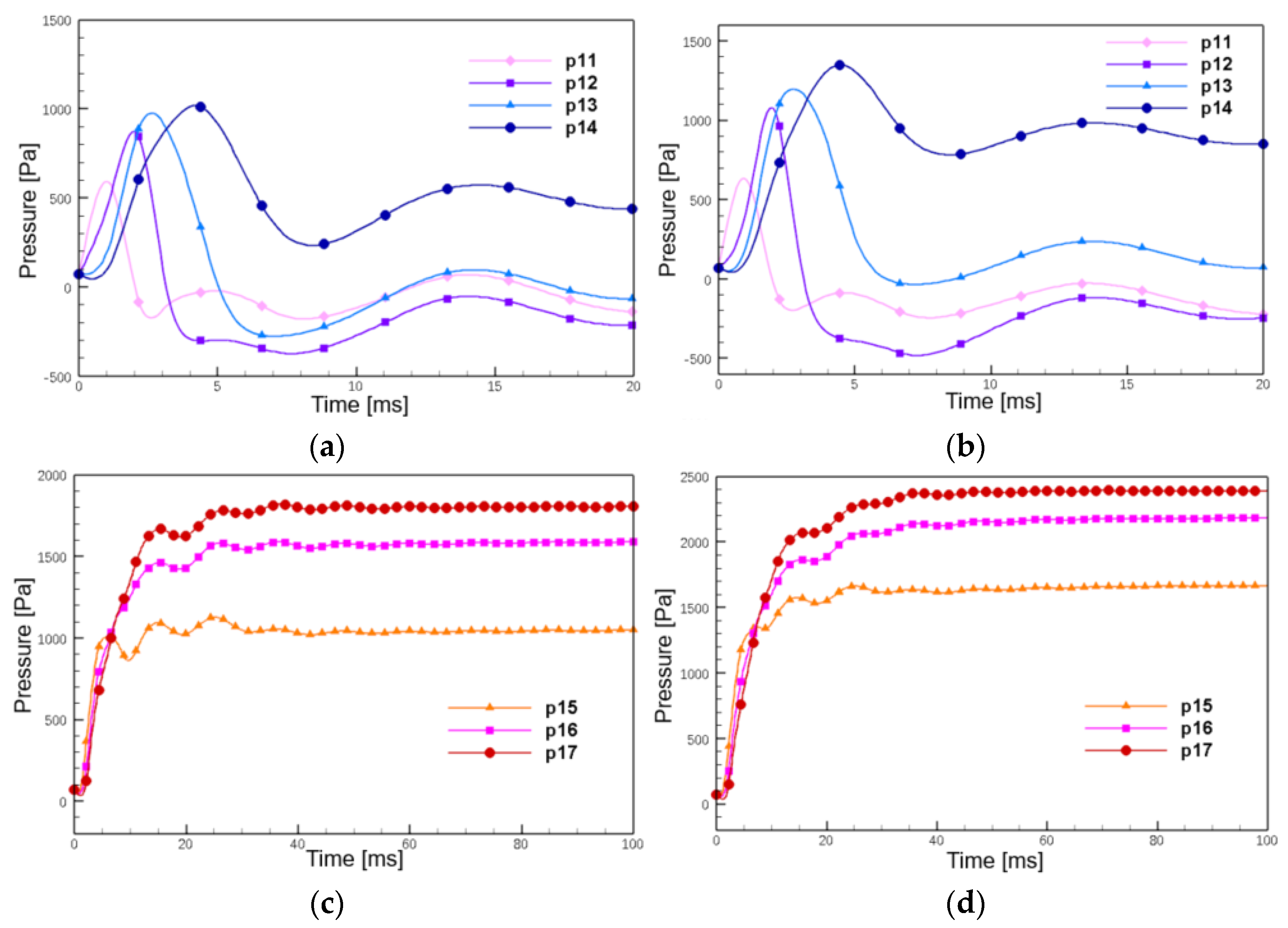
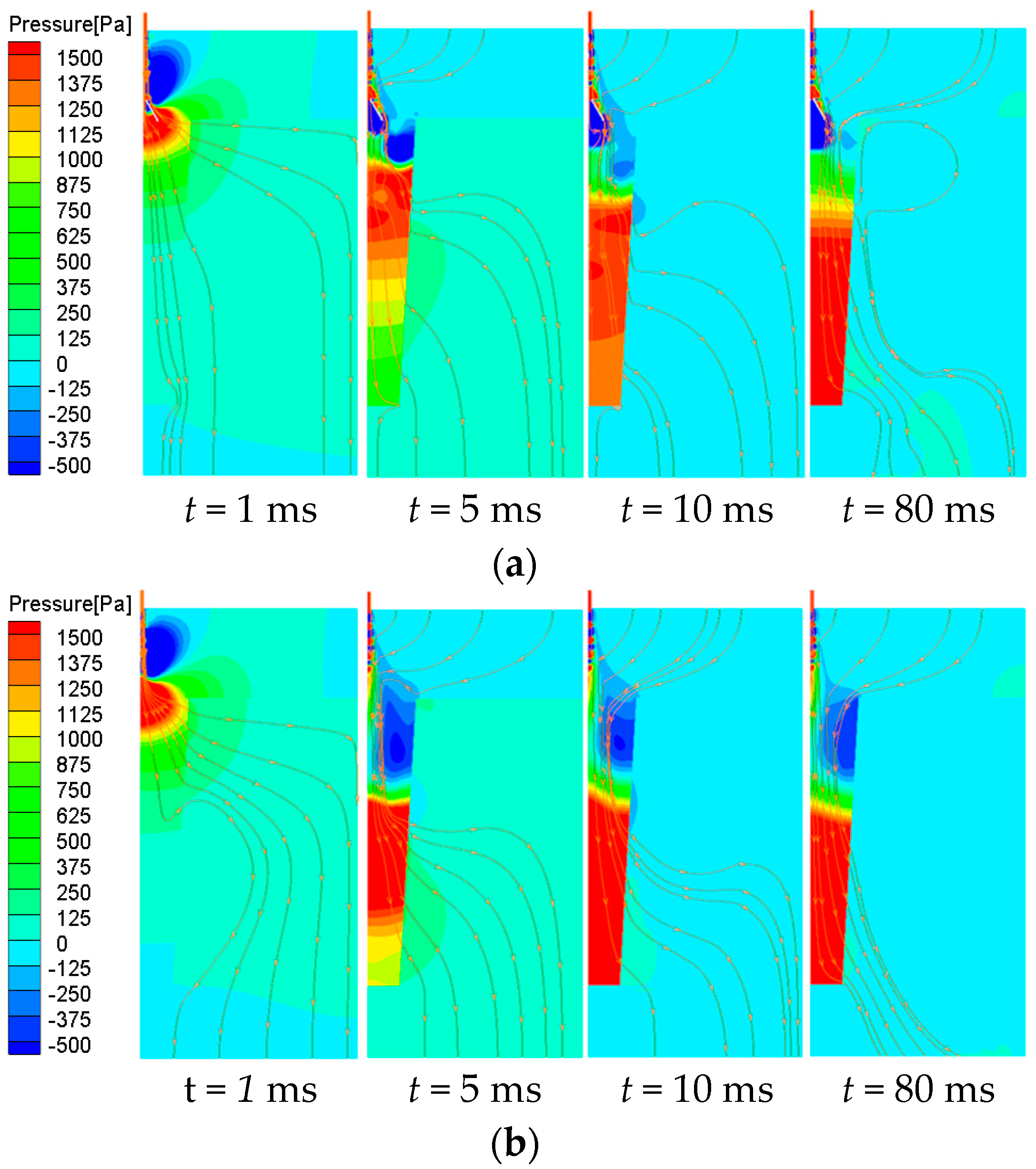
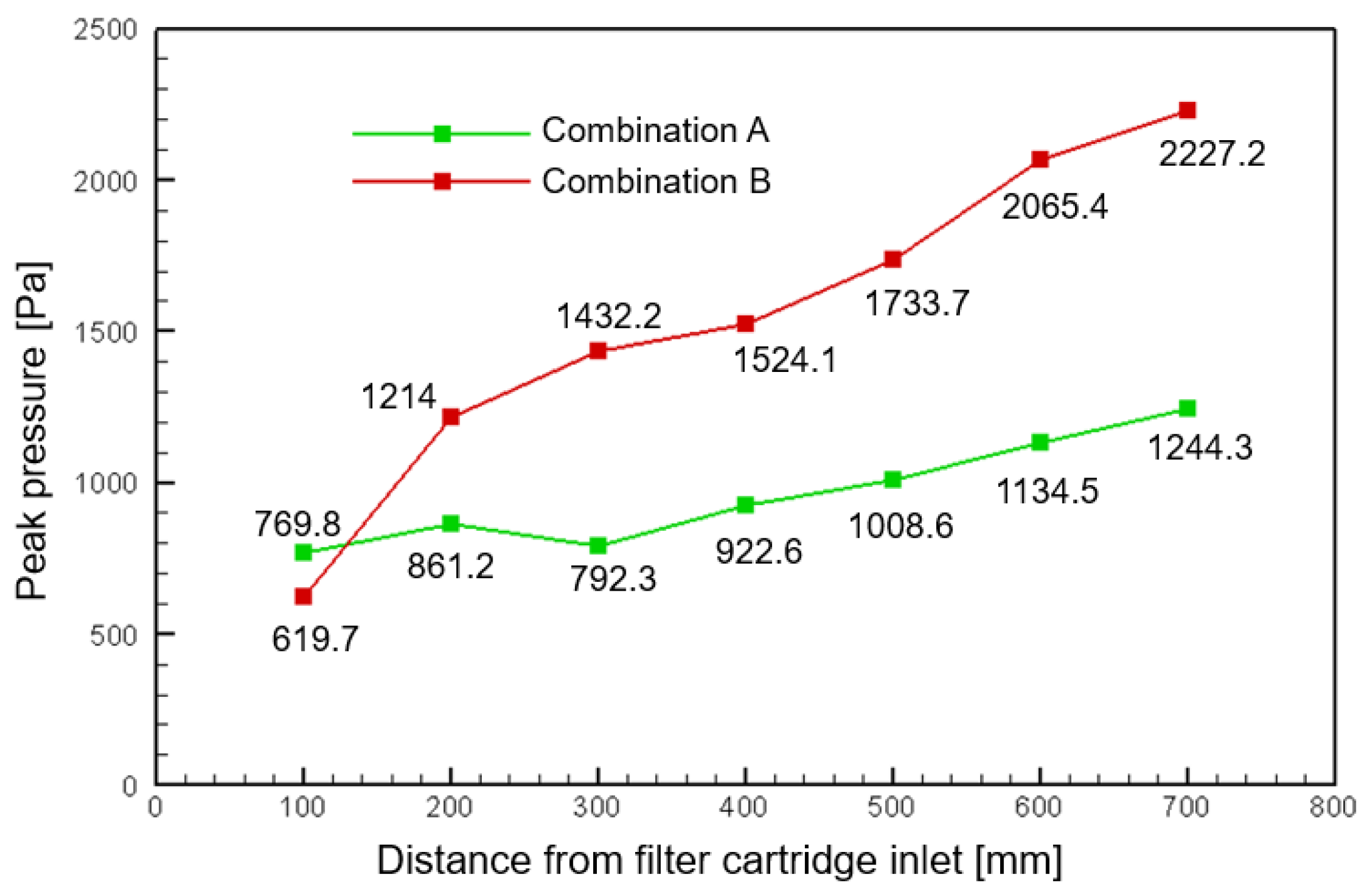
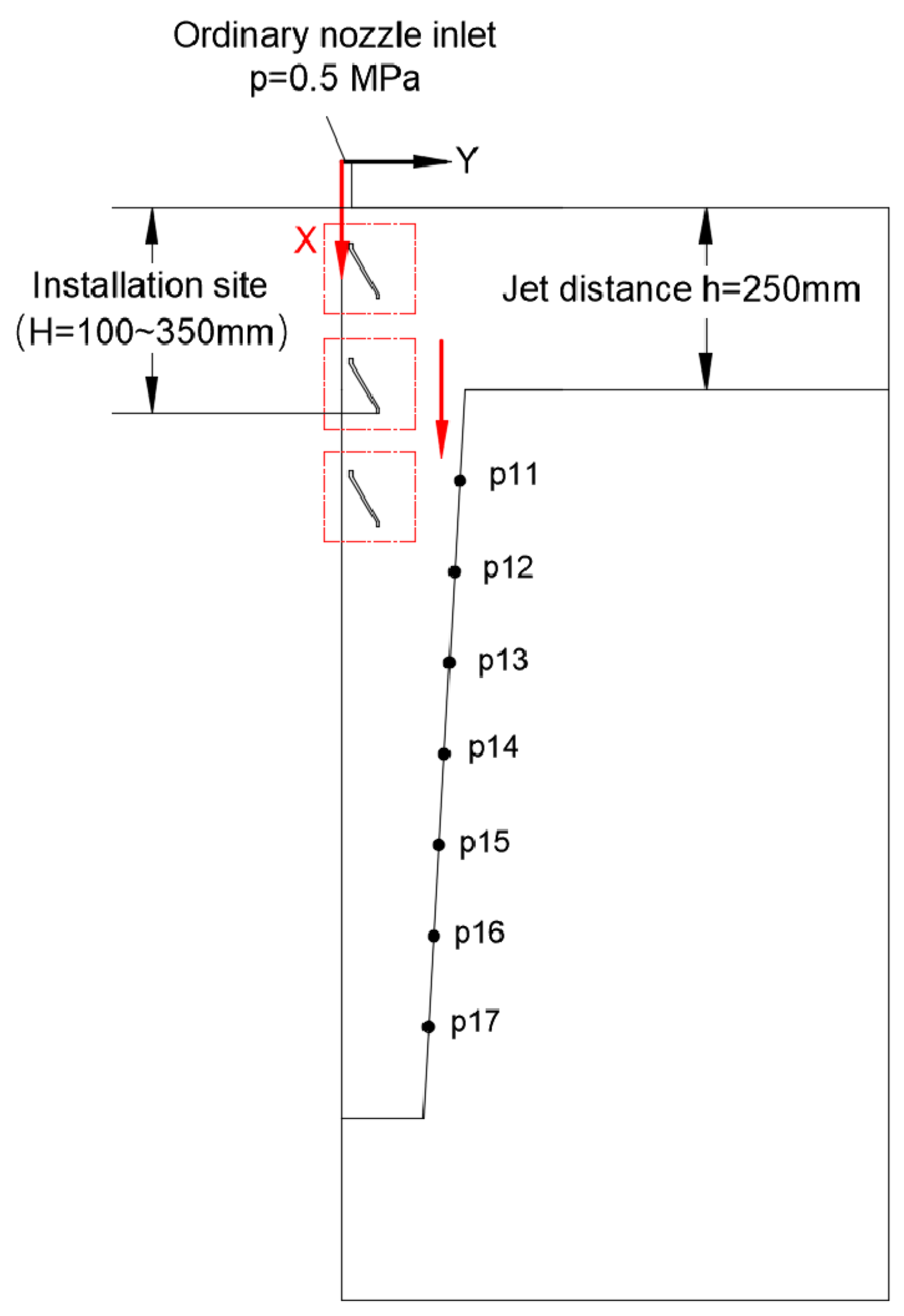
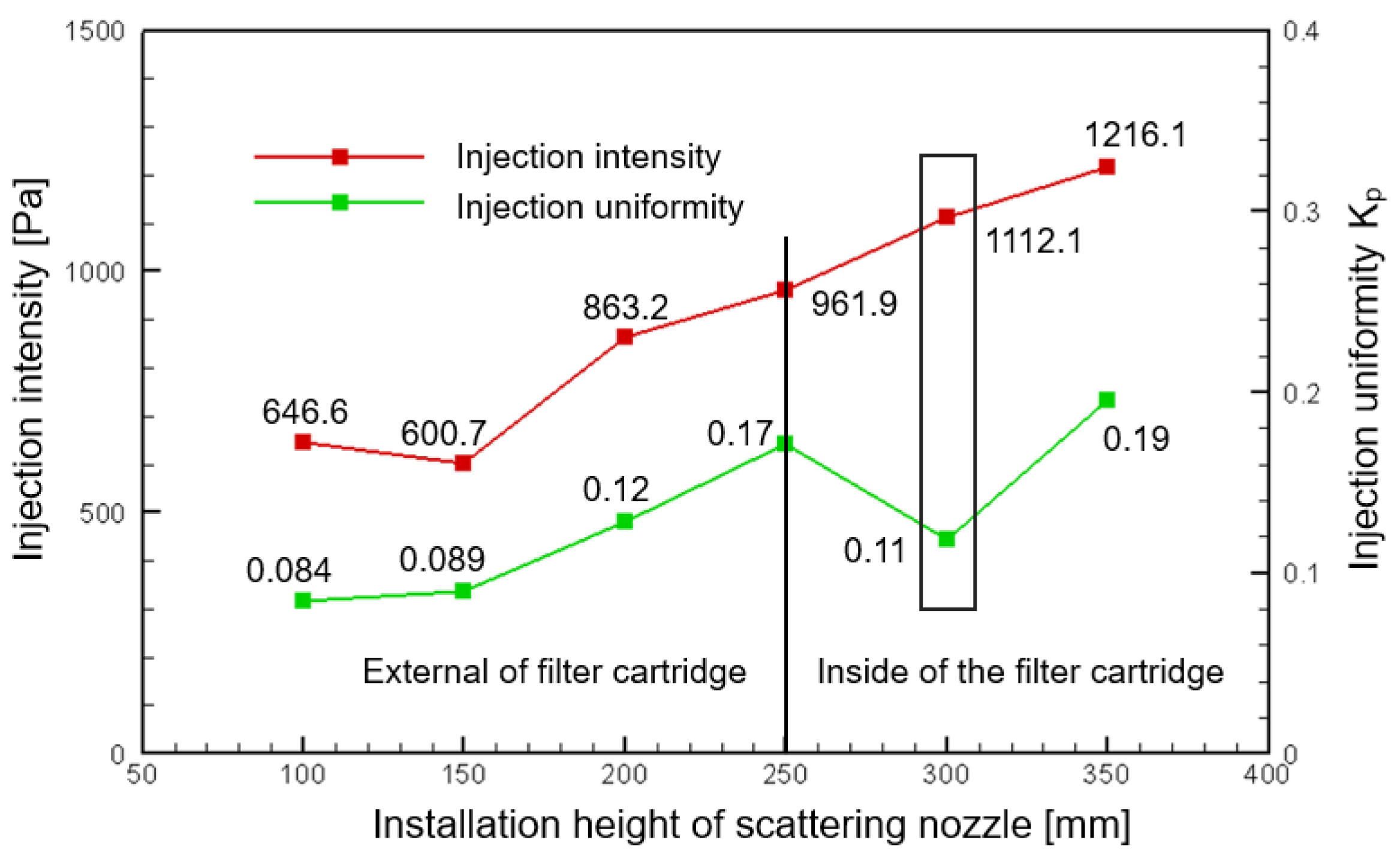
| Boundary Conditions | Parameter Setting |
|---|---|
| Inlet | Pressure-inlet, 0.5 Mpa |
| Hydraulic Diameter | 20 mm |
| Turbulent Intensity | 5% |
| Outlet | Pressure-outlet, 0 Pa |
| Wall Roughness | 0.5 |
| Shear Condition | No Slip |
| Calculation Model | Model Setting |
|---|---|
| Solver | Pressure-Based |
| Time | Transient |
| Pressure-Velocity Coupling | Coupled |
| Energy | On |
| Viscous Model | Realizable k-ε |
| Near-wall Treatment | Standard Wall Functions |
| Materials | Ideal-gas |
| Gradient | Least Squares Cell Based |
| Monitoring Points | Normal Nozzle and Cylindrical Filter Cartridge | Normal Nozzle and Conical Filter Cartridge | ||
|---|---|---|---|---|
| Primary Pressure Peak (Pa) | Peak Pressure (Pa) | Primary Pressure Peak (Pa) | Peak Pressure (Pa) | |
| p11 | 591.9 | 591.9 | 635 | 635 |
| p12 | 871.7 | 871.7 | 1077 | 1077 |
| p13 | 976.4 | 976.4 | 1197.1 | 1197.1 |
| p14 | 1018.3 | 1018.3 | 1346.6 | 1346.6 |
| p15 | 1002.7 | 1126.4 | 1350.3 | 1665.5 |
| p16 | 1462.7 | 1580.7 | 1863.1 | 2182.5 |
| p17 | 1667.8 | 1819.6 | 2070.7 | 2392.7 |
| 1084.5 | 1140.7 | 1362.8 | 1499.4 | |
| Injection Parameter | Variable | Invariant |
|---|---|---|
| Installation position (H/mm) | H = 100, 150, 200, 250, 300, 350 | p = 0.5 MPa H = 250 mm |
Disclaimer/Publisher’s Note: The statements, opinions and data contained in all publications are solely those of the individual author(s) and contributor(s) and not of MDPI and/or the editor(s). MDPI and/or the editor(s) disclaim responsibility for any injury to people or property resulting from any ideas, methods, instructions or products referred to in the content. |
© 2023 by the authors. Licensee MDPI, Basel, Switzerland. This article is an open access article distributed under the terms and conditions of the Creative Commons Attribution (CC BY) license (https://creativecommons.org/licenses/by/4.0/).
Share and Cite
Yi, J.; Duan, J.; Yuan, R.; Bo, W.; Ruan, X. Modeling and Cleaning Performance Optimization of Conical Filter Cartridge of Gas Turbine Intake Filter. Processes 2023, 11, 2584. https://doi.org/10.3390/pr11092584
Yi J, Duan J, Yuan R, Bo W, Ruan X. Modeling and Cleaning Performance Optimization of Conical Filter Cartridge of Gas Turbine Intake Filter. Processes. 2023; 11(9):2584. https://doi.org/10.3390/pr11092584
Chicago/Turabian StyleYi, Jiangang, Jiayi Duan, Rui Yuan, Wen Bo, and Xiaolong Ruan. 2023. "Modeling and Cleaning Performance Optimization of Conical Filter Cartridge of Gas Turbine Intake Filter" Processes 11, no. 9: 2584. https://doi.org/10.3390/pr11092584
APA StyleYi, J., Duan, J., Yuan, R., Bo, W., & Ruan, X. (2023). Modeling and Cleaning Performance Optimization of Conical Filter Cartridge of Gas Turbine Intake Filter. Processes, 11(9), 2584. https://doi.org/10.3390/pr11092584







